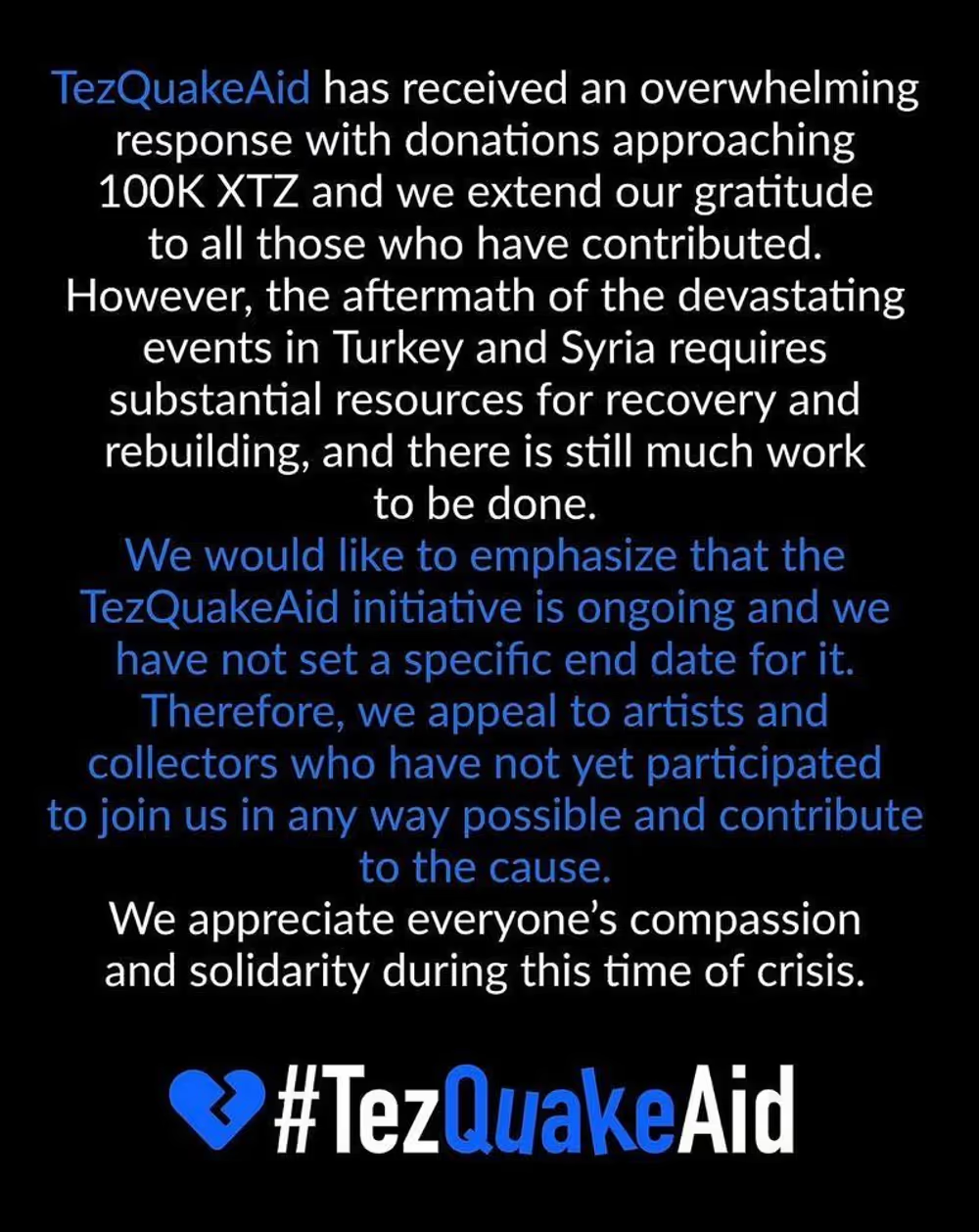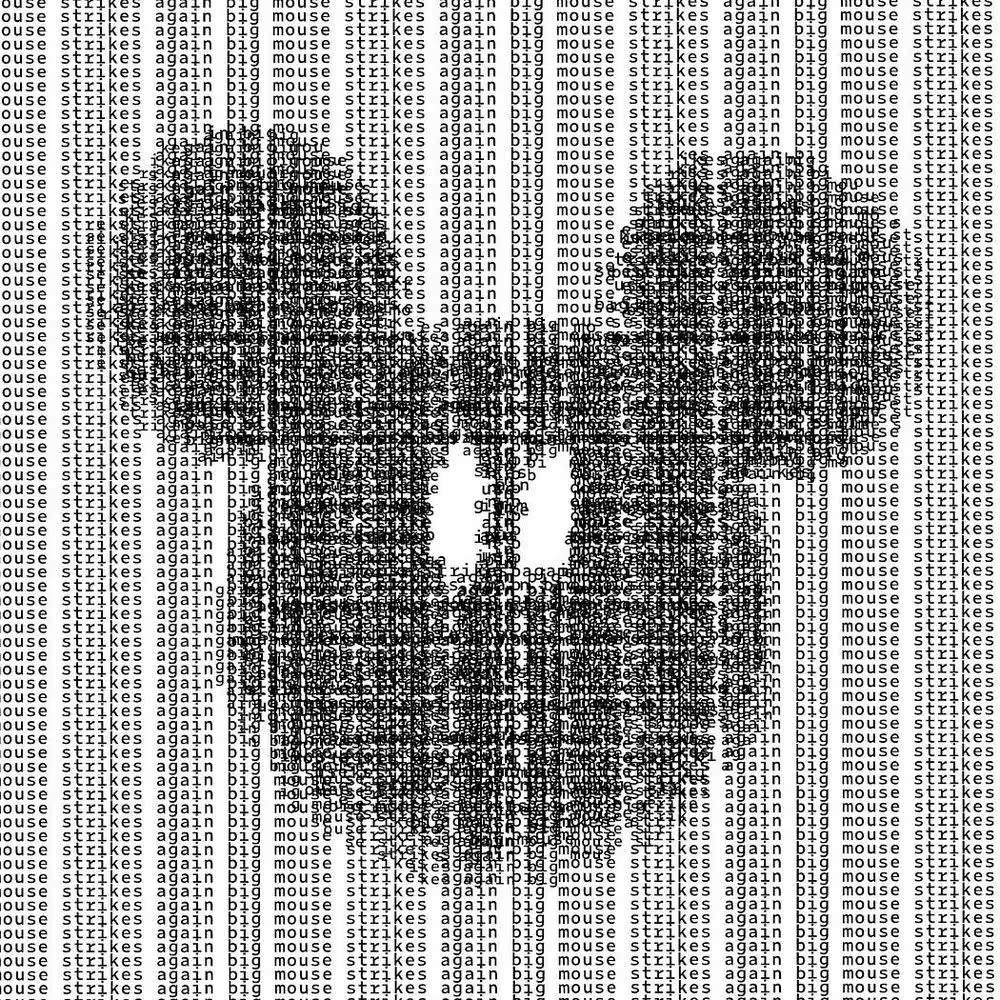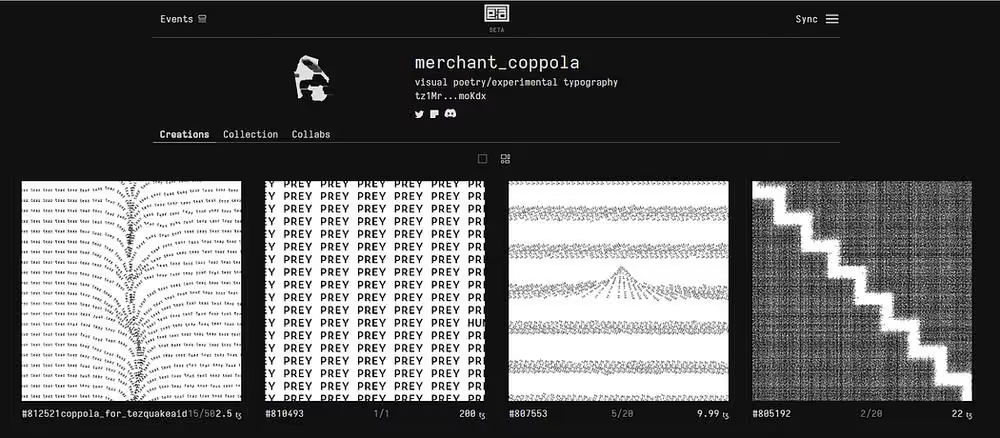Tezos Community Spotlight: Merchant Coppola
A deep dive with Merchant Coppola — digital artist, philanthropist, and all-around fascinating member of the Tezos community.
16 minute read

Just in case you missed the first 6,000 times I said it, I’ll say it again: the Tezos ecosystem is chocked-full of talented and fascinating people. These talented and fascinating people are building some of the coolest, most innovative tools and applications in the blockchain world. As far as the amazing ongoing evolution of the Tezos ecosystem is concerned, that’s excellent news.
Here’s the bad news.
With so many dynamic individuals now plying their various trades in the Tezos ecosystem — and more joining our heaving ranks every day — it’s all too easy to lose track of exactly who’s who and what’s what in this thriving community.
That’s why I’ve made it my mission to dive in and get to know the fabulous folks dedicating their precious time and energy to advancing the Tezos cause and to shine a spotlight on the awesome projects they’re working on.
In this edition of the Tezos Community Spotlight, I had the exciting opportunity to sit down with the one and only Merchant Coppola — digital artist, philanthropist, and all-around fascinating member of the Tezos community. Merchant Coppola is one of the fine Tezos folks behind TezQuakeAid, the Tezos community initiative raising funds for Non-Governmental Organizations (NGOs) to provide rescue operations, relief, and support to those affected by the devastating earthquakes that rocked Turkey and Syria this past month.

TezQuakeAid has raised and distributed tens of thousands of dollars (over 95K tez as of this writing) in relief aid to NGOs on the ground in the affected areas through donations and the minting/sale of digital artworks on the Tezos blockchain. This initiative stands as testament to the supportive, giving spirit of the Tezos community and its members, as well as the smooth decentralized operations the Tezos ecosystem is famous for.
As a driving force behind the laudable TezQuakeAid initiative and a well-established member of the thriving Tezos arts community, when Merchant Coppola offered me the chance to sit down for a chat about TezQuakeAid and his experiences in the Tezos ecosystem, I knew it was too good to pass up.
So let’s zoom in together, and get down to the brass tacks of Tezos fundraising and digital art with Merchant Coppola to learn a little bit about what makes this digital creator tick…
Profiles in Tezos’ness: MerchantCoppola

Stats:
Name: Merchant Coppola
Title: Teia Project Coordinator
Home: CET
Superpowers: Communication, Concrete Poetry, Community building
Background:
Merchant Coppola got his start in the world of art early. Raised in a family that included a sculptor mother and a painter uncle, Merchant Coppola says he grew up “in dusty workshops full of clay, paint, and other art supplies”. A regular museum attendant since as far back as he can remember, the decision to focus his energies on artistic endeavors was an easy one.
Merchant Coppola studied design and animation in school, and has worked in the visual effects (VFX) industry for the better part of 8 years now. He also regularly teaches University-level VFX classes in addition to his blockchain-based artistic and philanthropic activities.
Despite being immersed in the world of art throughout his life, Merchant Coppola says that he never really considered himself an “artist” until he stumbled into the emerging field of NFT-based digital art and combined his love of literature with his digital design skills through text-based art.
Merchant Coppola says that his transition to text-based digital art as NFTs was a natural one. During the height of the Covid pandemic, he, like so many others, began exploring new concepts, hobbies, communities, and ideas, and began researching the concepts around digital assets. Once he started experimenting with typographic animation and NFTs, all the pieces came together.
Merchant Coppola says that his interest in blockchain technology, digital ownership, and NFTs centers not so much in “the hyper economics of blockchains”, but more so in this technology’s potential to create space for real change. Its promise to upend existing models of governance, and trustless approach to data and the “huge and undiscovered socio-technological potential” made the fledgling blockchain space an intriguing one that Merchant Coppola felt compelled to explore further.
As he delved deeper into the communities and concepts of the blockchain world, Merchant Coppola found himself gravitating more and more toward the Tezos ecosystem. In his words, “I am interested in the social potential of blockchains. IMO building a good social ecosystem is at least equally as interesting as the tech side. Tezos to me feels like it has the right environment for both. That’s what I am here for.”
In the growing community surrounding discontinued NFT art platform Hic Et Nunc (HEN), Merchant Coppola discovered the thriving community of like-minded folks he’d been searching for. It was, he says, “the perfect place for exploring what NFTs can be and trying all kinds of silly ideas around them.”
After participating in the writing of the “Hicetnunc Manifesto” (an early version of what would go on to become digital art platform Teia’s “core values and code of conduct”, Merchant Coppola was hooked. Active on HEN throughout 2021, when the platform was discontinued, Merchant Coppola joined in on the effort to enable the community’s transition to Teia, a community-managed, open-source platform for Hic Et Nunc’s codebase and community.
Merchant Coppola says that Teia has become “my home in the ecosystem”, and he now operates not only as an artist, but also as a project coordinator in the Teia community. Facilitating charity work is an integral part of Teia’s mission, which made the platform a fertile ground for the TezQuakeAid initiative. While many Teia contributors are heavily involved in TezQuakeAid, TezQuakeAid is not organized by Teia itself. Rather, TezQuakeAid was an initiative that arose spontaneously, bringing together people from all corners of the Tezos ecosystem — many of whom had never even met before — in a common cause. This makes TezQuakeAid, in Merchant Coppola’s words, “a great example of what decentralisation and horizontal, chaotic structures can create!”
What does Merchant Coppola have to say about his experience in the Tezos ecosystem and his part in making TezQuakeAid such a successful Tezos-powered charity initiative?
Let’s ask him…
A Quick Q&A with Merchant Coppola

1) What can you tell us about your journey into the Tezos ecosystem so far? What’s it been like to dive into this world?
Its been funny, silly, exhausting, challenging, intriguing, playful, and fascinating. From the early ecstasy of hic et nunc to the slow but steady bear market building, it really feels like a parallel world that absorbs me at times. I work with people from around the globe on a daily basis, think in different time zones, and share in common interests.
2) What does a day in the life of a digital artist operating in the Tezos ecosystem look like?
Oh, that’s a good question. For me the day begins around 8 am with my “morning slot” as i call it: i use the first 2 hours of my day to read up on discord messages, write emails, ping people about Teia stuff, etc. sometimes there are meetings, and sometimes i mint something that i have prepared the previous day.
During the day i mostly work at my day job, with regular peeks into discord on the side.
After work and dinner, I go into my night slot: here is when I do my art, send out emails and message to people about Teia to-dos, etc.
Then I take 2 hours of family time before I begin my night shift, during which I finally get to do creative work without much distraction.
Sometimes it’s hard to still do art while managing a rather big community — but for me, the Teia project is of enough importance to make it my priority. Sometimes it also helps me with my own art: I am always looking for phrases, and “fleeting ideas”. Often these are the result of talking to others or hanging on discord.
Lately I’ve also shifted my methods of creating a bit: while I used to do a lot of work on my pieces directly in the software, I’ve shifted a bit to doing more sketching solely in my head while going for a walk. It feels very cool to imagine visual ideas and then just “get them done” on the computer. And it helps me work on my art during my off-time almost like a meditation practice, which is very calming and fun.
3) How would you describe Teia to someone who’s never heard of it before?
It is a marketplace for NFTs that is truly community owned and managed, it is open source, which means everyone can use the code of the website to set up their own marketplace.
The intriguing part about Teia, in my opinion, is that its explicitly not built like a classic company — ie: with the goal of maximizing the companies profits. It’s an open co-working space in the true spirit of hacker culture — a shared project of artists, collectors, and builders that have made a place for themselves together in their free time. To me such a place is a healthy addition to our ecosystem and has a huge potential to “stabilize” the culture of our shared space and allow for more experimentation and creative chaos than other marketplaces that need to turn some numbers at the end of the month.
4) What inspired the TezQuakeAid team to get active in supporting those affected by the earthquake in Syria and Turkey?
To me, one of the main reasons why initiatives like this are such an integral part of the Tezos art experience is the culture that spawned from hic et nunc back in the day. It was a small and very global community that always had a huge sense of global solidarity — empowering underrepresented artists, fostering connections between the global north and south, etc. It’s this spirit that has lead to countless community-driven fundraising events since the Tezos art scene took off: we’ve had fundraisers for Afghanistan, Pakistan, the Turkish wildfires, the Iranian woman fighting for their liberty, and the war in Ukraine, just to name a few.
I think another reason why TezQuakeAid has seen a lot of traction in our community is because the Turkish community is very well represented within the Tezos art community. I believe representation is the key to a healthy global community. When deciding which organizations to donate to, the Turkish community members’ voices were the key to determining which orgs are most active on the ground (and trustworthy).
Also, for TezQuakeAid, i feel like the right bunch of people teamed up fairly quickly and had good chemistry to collectively make the event possible. Time is always the biggest enemy of these fundraisers — ie: if the event starts after the global media attention has already moved on, it gets incredibly hard to mobilize support. Luckily, TezQuakeAid was set up within 1-2 days after the earthquake due to a very focused and well organized team. Again: these were all people from various corners of our ecosystem coming together to build, which is truly amazing!
5) What makes blockchain in general, and Tezos specifically, an effective tool for this kind of charitable fundraising?
The obvious answer is that trustless, public transactions ensure transparency. To be fair though, there is one catch as of now: Most organizations don’t have direct crypto wallets. Often this means crypto fundraisers need to rely on services that offramp the crypto to fiat donations, which adds a “middleman” to the mix and doesn’t always help with transparency.
For TezQuakeAid, luckily, The Tezos Foundation agreed to help us by facilitating the donations to the ORGs by taking our Tezos and wiring the donations directly to the organizations on the ground.
We have seen a lot of steps into the right directions: some orgs have already started to set up their very own crypto donation wallets, which unlocks the true advantages of crypto donations. Blockchain-based donations can be automated via smart contracts (like for example artists directing their creators royalties towards a crypto wallet), every transaction and donation is fully transparent and public, plus you can generate statistics to monitor the donations, etc.
Thinking long-term, I recently became fascinated by the idea of managing fundraisers via voting tools. For TezQuakeAid we set up a multisig to manage the donation wallet, but there is much more potential here i think. For example, many artists donated their creators royalties towards the TezQuakeAid multisig, which means a smaller but steady flow of royalties will come into the donation wallets in the long run — even years from now! The question will become: if the earthquake relief is no longer needed, what to do with the incoming royalties? There are multiple options like donating to a more general “max impact fund” that looks for ways to provide the maximum positive impact of every tez, or we could use the blockchain to let everyone who has contributed their royalties vote on where the money should go to. Due to the public data on-chain, you can rather easily define based on blockchain data who can take part in a vote. This of course is all just me dreaming, but I see a lot of potential use cases for blockchain technology in regards to charity initiatives.
6) What has the response been like from the Tezos community?
I think it is fair to say that solidarity is more than just a word to the Tezos community: we all care for each other.
Around 1000 artists minted around 2000 artworks as of writing this (25 feb). Tezos-based marketplaces were quick to set up documentation, open up their front pages for the event, and help with improving their UIs for the fundraisers. Independent collectors helped with promoting the pieces, and Turkish artists constantly updated the community on the situation on the ground.
The community is not (yet) too big, so the whole Tezos ecosystem can rather quickly mobilize enough people to make a fundraiser like this happen. It is thanks to hours over hours of work from people across the Tezos ecosystem that we were able to raise around 100k tez within a week together without any predefined organizational structure, which IMO is quite impressive.
7) What are the funds being raised being used for?
We want to make sure the Funds are directed towards Earthquake relief in Turkey and Syria. For the first two donation distributions (50k Tez each) we allocated 70% towards the Turkish NGO AHBAP, which was suggested by our Turkish community members. They said they trust AHBAP, and the work they are doing on the ground.
For Syria, things are a lot trickier: There are areas of Syria that are controlled by the Syrian government, which is not only under international sanctions but is known for misusing donations and aid. We will need to stick to orgs that are suggested by our Syrian community members and that are legally safe for us to donate to.
And, since we need to go by very little and constantly changing info, the 30% for Syrian causes will need to be adjusted to the situation. Thus far for the Syrian part of the fundraiser, we have donated to the Syrian American Medical Society, Save the Children, and soon the Red Cross (which also has a dedicated Syrian fund).
We are always looking for new ORGs we can include in our fund, especially to cover government-controlled areas.
The usage of the donations will also need to be dynamic. While medical aid has been most important in the first days after the catastrophe, food, shelter and sanitary solutions will be the next priorities for the people affected. So we too need to asses the situation and maybe if needed adjust the recipients of the donations we raise. I think it is unlikely, however, we will change AHBAP as the sole receiver of donations for the Turkish side of things. From all our Turkish friends’ reports, they seem to do an excellent job in helping the people on the ground.
8) How/where can people who want to support and participate in TezQuakeAid get involved?
Either mint a fundraiser piece and use one of the Tezos marketplaces that offer revenue splitting (Teia, Objkt.com, Versum, FxHash) to direct a set % of the revenue towards the donation address, collect fundraiser pieces, or donate Tezos directly to the fund or promote the event via social media.
On the event page on joyn.xyz, you can find guides and articles as well as transaction details and a FAQ section: https://app.joyn.xyz/space/tezquakeaid-ec7f1f650671
Also, if there are any further questions, feel free to jump onto the Teia discord server or contact me on the TezQuakeAid Twitter account; dms are open, especially when it’s about TezQuakeAid!
I want to give a huge shout-out to all the organizers and people involved in setting up the TezQuakeAid fundraiser, as well as all artists and collectors that participate. I think in times like this, the true nature of our ecosystem shows!
While the full potential of Tezos as a vehicle for philanthropic fundraising has yet to be unleashed, laudable grassroots initiatives like TezQuakeAid demonstrate the value that our ecosystem can provide to the world in times of crisis.
With folks like Merchant Coppola and the rest of the TezQuakeAid community dedicating their considerable efforts to causes like this, the Tezos ecosystem’s potential to do good in the world truly is enormous as it is on full display. If that’s not something everybody in this ecosystem can take pride in, I don’t know what is! Cheers to you all at TezQuakeAid and a hearty salute for your efforts!